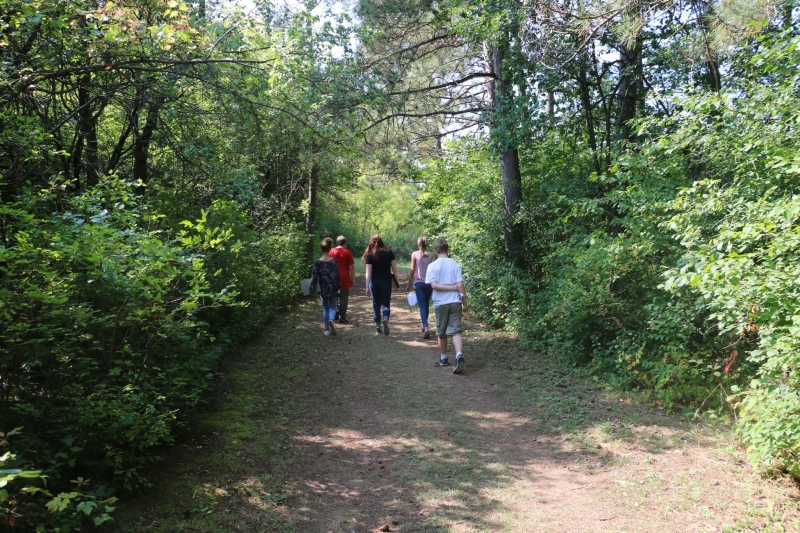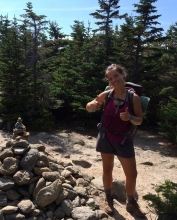
7th graders at Norwood-Norfolk Central School walk out of the woods after a lesson on nature observation with Nature Up North this September.
Trees and Streams: Citizen Science in the Schools
A student shouts— “This one! This one’s ours!” and runs back for a measuring tape. She and her partner have found their assigned maple tree on the school lawn, and are about to record seasonal observations for the first of many weeks this fall. The student, a 7th grader at Norwood-Norfolk Middle School, is participating in Monitor My Maple - one of several citizen science initiatives at Nature Up North.
Welcome to our fall citizen science update! Here, we’ll share photos from some of our class visits this fall, and will outline the two projects we’ve been focusing on. It’s been a busy fall for citizen science here in the North Country, and over 300 students in 7 schools have been busy getting outside to collect data. We think it’s about time we recognized their hard work!
But first, what is citizen science? Citizen science is scientific data collected by community members (students, teachers, families and friends) in coordination with local scientists. Nature Up North citizen science projects are community-based science initiatives that each focus on a current environmental concern. Every year, students, teachers and community members across the North Country help us collect data that is meaningful for both local and global communities. Our current projects focus on sugar maple decline, local water quality, invasive species, and seasonal and recreational data.
Photo: Students in the St. Lawrence Sustainability Program get an introduction to Monitor My Maple, September 2017.
Monitor My Maple, our flagship citizen science project, is straightforward and simple: participants choose a maple tree near their home or school, and record seasonal changes (phenology) they observe in the Fall and Spring seasons. Recent research indicates that sugar maples, a species at the heart of the North Country community and economy, may be in decline. Some scientists are concerned that the increasingly unpredictable climate may be negatively affecting sugar maple growth. To find out, citizen scientists all around the North Country have been working with Nature Up North to collect important data on sugar maples since 2014.
At Norwood-Norfolk Middle School, the excited student and her classmates are monitoring maples for the first time this fall, but the trees they’re studying aren’t new to the project. Susan Dodds, who teaches 7th grade science, started working with Nature Up North last fall. The goal of Monitor My Maple is to monitor the same trees year after year. The long term phenology study will allow Nature Up North to determine if, and how, seasonal patterns in sugar maple growth are shifting.
Meanwhile at a nearby stream, students in the Living Environment class at Canton Central School are collecting data of a wetter variety:
Photo: 8th graders at Canton Middle School during a water sampling lesson on the Grasse River at the SUNY Canton foot bridge, October 2017.
MOW the Grasse (Monitoring Our Water), is a new water monitoring initiative at Nature Up North. The pilot project combines the need for regular water testing on the Grasse River with the value of environmental stewardship and place-based education. Made possible by grants from the St. Lawrence River Research and Education Fund and the Walker Foundation, MOW the Grasse aims to build a community-based water quality monitoring program in the North Country.
Photo: Students at the Deep Root Center in Canton collect data on stream velocity at Heritage Park for MOW the Grasse, September 2017.
Nature Up North is working hand-in-hand with the St. Lawrence Land Trust, Grasse River Heritage, and several local schools to test the water sampling protocol before the project officially launches Spring 2018. This Fall, MOW the Grasse sampling materials were used in science lessons with students at Canton Central School, Edward-Knox High School, Little River Community School, SUNY Potsdam, and the Deep Root Center in Canton.
In the meantime, in addition to the busy students at Norwood-Norfolk, others at Canton Central, Edward-Knox, Colton-Pierrepont, and St. Lawrence University have been busy at work monitoring their maple trees. They may be staying drier, but their data collection isn't over until all the leaves have dropped!
Thanks to the hundreds of students and teachers who have made valuable contributions to our citizen science projects this year - we couldn't do it without you.
Want to get involved? Reach out to Emlyn (ecrocker@stlawu.edu) to learn how YOU too can participate in citizen science.

